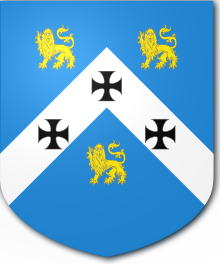Fowler baronets
Four baronetcies have been created in the surname of Fowler, all of which are now extinct.
The Baronetcy of Fowler of Baronetage of England on 21 May 1628 for Thomas Fowler and was extinct on his death in 1656.
The Baronetcy of Fowler of King Edward IV.
The Baronetcy of Fowler of Gastard House in the Parish of
Member of Parliament
The Baronetcy of Fowler of Forth Railway Bridge.
Fowler of Islington (1628)

Created in the Baronetage of England.[3]
- Thomas Fowler, 1st and only Baronet (1586–1656) Extinct on his death
Fowler of Harnage Grange (1704)

Created in the Baronetage of England.[4]
- William Fowler, 1st Baronet (died 1717)
- Richard Fowler, 2nd Baronet (died 1731)
- William Fowler, 3rd Baronet (1718–1746)
- William Fowler, 4th Baronet (died 1760)
- Hans Fowler, 5th Baronet (died 1773) Extinct on his death
Fowler of Gastard House (1885)

Created in the Baronetage of the United Kingdom.
- Robert Nicholas Fowler, 1st Baronet (1828–1891)
- Thomas Fowler, 2nd Baronet (1868–1902) Extinct on his death. Survived by seven of his ten sisters, including Jean Elizabeth and Rachel Elfreda.
Fowler of Braemore (1890)

Created in the Baronetage of the United Kingdom.[5]
- John Fowler, 1st Baronet (15 July 1817 – 20 November 1898)
- John Arthur Fowler, 2nd Baronet (27 June 1854 – 27 March 1899), son of the 1st Baronet
- John Edward Fowler, 3rd Baronet (21 April 1885 – 22 June 1915), son of the 2nd Baronet
- Reverend Montague Fowler, 4th Baronet (12 November 1858 – 1 April 1933), 3rd son of the 1st Baronet. Extinct on his death as he had two daughters but no son.
References
- ^ "No. 25496". The London Gazette. 31 July 1885. p. 3540.
- ^ "No. 26043". The London Gazette. 18 April 1890. p. 2273.
- ^ Burke's Genealogical and Heraldic History of the Extinct Baronetcies of England Ireland and Scotland (1844) p 209
- ^ Burke's Genealogical and Heraldic Dictionary of the Extinct Baronetcies of England Ireland and Scotland (1844) p 208
- Who Was Who. A & C Black/Oxford University Press. Retrieved 8 June 2010.
